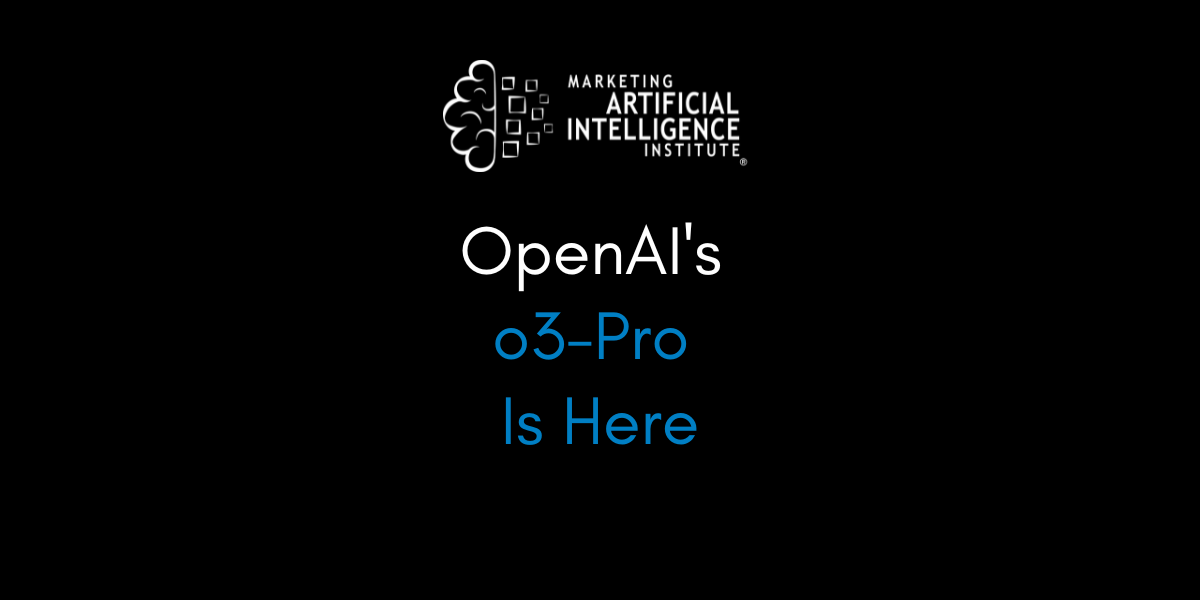OpenAI just released o3-Pro, its most capable reasoning model yet.
o3-Pro is a big leap forward from its predecessor, o3, and is especially strong in domains like coding, science, and math.
What sets o3-pro apart is its depth: It's slower, pricier, and much more compute-heavy. But that also gives it a leg up against other leading models. In benchmark tests, OpenAI says it outperforms top rivals like Claude 4 Opus and Gemini 2.5 Pro.
What do you need to know about o3-Pro? And how do you make the most of it?
I got the scoop from Marketing AI Institute CEO Paul Roetzer on Episode 153 of The Artificial Intelligence Show.
Not Just Smarter, But Different
o3-Pro is a bit of a different animal than previous models. While o3 already impressed with strong performance in coding, math, and science, o3-Pro raises the bar across the board. OpenAI says expert reviewers consistently preferred o3-Pro in every tested category, from education and business to programming and writing help.
The catch? O3-Pro is slower and more expensive than the standard models. It's compute-intensive and deliberate by design. This isn’t the model you turn to for quick tasks. It’s for deep work on the kind of strategic, multi-step reasoning that demands real cognitive firepower.
"It's very slow," says Roetzer. "The main difference is it just takes longer to think, which enables all these benefits."
Because of that, o3-Pro shines when used thoughtfully, with the right context and complexity. Early testers, like those writing at Latent Space, say it actually helps to treat this model more like a report generator than a chatbot. Provide it with lots of rich context. Give it a goal. Then get out of its way and let it think.
Context Is King
One of the key takeaways from early experimentation is just how hungry o3-Pro is for context. The model thrives when you feed it deep, relevant information. A quick chat won’t show you what it can do. But task it with strategic planning, analysis, or long-form reasoning? That’s when it reveals its full potential.
In their experiments, the team at Latent Space discovered this firsthand. By giving o3-Pro access to months of internal planning documents, goals, and even voice memos, the model generated a specific, actionable strategy that changed how they thought about their business. Not a generic response, but rather a genuinely valuable plan, complete with timelines and priorities.
These kinds of results are hard to capture in a benchmark. But they show why o3-Pro matters: It performs best when integrated into real-world tasks that require thinking, not just talking.
Tools, Memory, and Meta-Reasoning
Part of what makes o3-Pro so capable is its enhanced use of tools and memory. It's not just better at solving problems. It's better at knowing when to call on tools, what questions to ask, and how to navigate its environment with precision.
According to OpenAI's documentation, o3-Pro supports file analysis, web search, visual inputs, and more. And it uses these tools more strategically than its predecessors. It doesn't just have access; it understands when and why to use each capability.
This meta-reasoning (thinking about thinking) is what sets o3-Pro apart. It's not just trying to complete a prompt. It's trying to solve a problem the way a capable human would: step by step, with deliberation.
The Slowest Model with the Highest IQ
In short, o3-Pro isn't for everyone or every task.
It costs more. It takes longer. And it demands more from the user.
But if you're working on complex strategy, advanced research, or high-stakes analysis, it may be your best bet.
And it may offer a preview of what the future of AI looks like: slower, smarter, and more capable than anything that came before.
Mike Kaput
As Chief Content Officer, Mike Kaput uses content marketing, marketing strategy, and marketing technology to grow and scale traffic, leads, and revenue for Marketing AI Institute. Mike is the co-author of Marketing Artificial Intelligence: AI, Marketing and the Future of Business (Matt Holt Books, 2022). See Mike's full bio.


